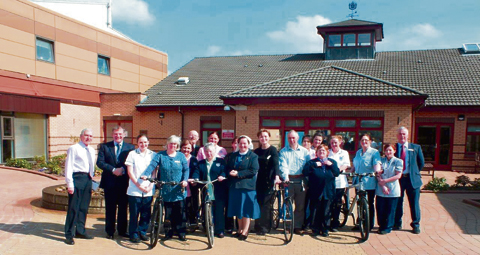September 13 | ![]() 0 COMMENTS
0 COMMENTS ![]() print
print

Lighting up lives at St Margaret of Scotland Hospice
SR RITA DAWSON from St Margaret of Scotland Hospice in Clydebank gives a historical insight into its workings and the people who have supported it
The Religious Sisters of Charity founded St Margaret of Scotland Hospice in 1950. The hospice is a Company Limited by Guarantee and remains part of the International Healthcare Facilities of the Sisters of Charity. Our Board of Directors is responsible to the Sisters of Charity for strategic decisions, and is a highly professional group of individuals, including solicitors, accountants, surveyors, bankers and clinical professionals.
The story of the hospice began when a man with advanced throat cancer approached a Sister of Charity. She had recently come to Clydebank to help teach in schools and with social and parish work. He told her he had nowhere to go, did not know what to do and was growing steadily worse with no one to care for him. The sister contacted the Mother House in Dublin to ask if it might be possible to send a sister trained in nursing who would look after this man and others similarly afflicted. With help from the local churches and the local community, sufficient money was raised to buy a house in Millbrae Crescent, including equipment and other necessary items needed to establish a small hospice. The first house was quickly outgrown and the house next door was bought and taken into use. Again, in a short time it was very obvious something further would need to be done if the needs of the very sick were to be met. The sisters decided a purpose built hospice would be the only answer.
The first turf of the new hospice was cut on July 19, 1969 and on September 29, 1971, the new hospice was opened to accommodate sixty patients: 30 patients with Palliative/End of Life Care needs and 30 patients with complex medical and nursing needs.
In June 1988, Sr Rita was able to introduce a new community palliative care service nurse, trained in palliative care who was able to support patients and their families/carers at home, providing pain and symptom management advice and offering psychological, social and spiritual support throughout the illness and in bereavement. Over the years, and in accordance with the need, this service has continued to develop and grow. Currently the service has three clinical nurse specialists in palliative care covering a wide geographical area providing care to both patients and families/carers living with cancer and other non-malignant life limiting illnesses.
Together with the board of management and in consultation with the then chairman of the Health Board, Sir Thomas Thompson, Sr Rita launched an Appeal Fund in 1989 for the re-development and upgrading of the hospice. On September 22, 1993, after much knocking on doors and other fundraising activities, the second floor and new day hospice were opened.
In October 1998, a new state of the art education centre was opened at the hospice. The facility was named the Sir Patrick Hamill Education Centre in recognition of Sir Patrick’s dedication and commitment to the hospice as its chairman over 15 years. Sir Patrick was a former Strathclyde Police chief constable and on his retirement became chairman of the hospice. Sir Patrick loved the hospice therefore it was only right and fitting this centre should be named after him.
Replacing Sir Patrick as chairman was Professor Brian Williams, a geriatrician who had served the hospice for over 23 years. The hospice library is named after him. Again, we salute Professor Williams for his continuing commitment to this hospice. He is now our vice president.
Professor Leo Martin, who is our current chairman, took over from Professor Williams having served as a Board Director for many years. Professor Leo is a young, energetic, vibrant, professional man who has his own Legal Practice in Glasgow. He has a huge social conscience and a great love for the hospice, together with a passion for defending the most vulnerable in our society. He was instrumental in campaigning to secure the continuing care beds at the hospice. He regularly meets with politicians, the Health Board, communicates with the media and the public in highlighting the importance of hospice care and the inequity in funding.
In October 2000, a new hydrotherapy pool was opened thanks to the great generosity of a wonderful man, Reverend Alfred Graham Charles Langford. Reverend Langford was a friend of Sr Rita and had provided great support to her and her work over many years. His wish was always to provide something both staff and patients could enjoy and what a wonderful and unique facility this is.
New legislation necessitated an upgrade to the Care of the Elderly facility in order to meet the new standards and to provide more single rooms. Sr Rita launched another appeal and in August 2006, the work began on a new 28-bedded unit to modernise the ward for elderly patients with complex medical and nursing needs. The new unit, named the Mary Aikenhead Centre, replaces the former St Margaret’s Ward at the hospice. With the patients’ needs in mind at all times, the centre was constructed to provide ten single rooms and nine twin rooms with the most up to date equipment. The rooms lead on to their own very private courtyard where the patients may sit and enjoy the summer sun.
Due to the extraordinary vision of Sr Rita, the Hospice has transformed from a single storey building, to the advanced specialist palliative care hospice it is today. Without the support of the community, many supporters, charitable trusts and the Sisters of Charity, it would have been impossible to achieve so much over the years. This continuing support is most highly important and greatly appreciated.
In 2012, St Margaret of Scotland Hospice received an excellent report from the regulator, Healthcare Improvement Scotland (HIS), who gave the hospice a maximum score of six out of six in every category—management /leadership, staffing, environment, information and care/support. This grading is due in no small part to the great teamwork which takes place each day in the hospice. We give sincere thanks to the board of directors, the senior management team, the medical/nursing staff, all the various support services, our volunteers and supporters in helping us to deliver the highest possible standard of care to those who need us at a most difficult time in their lives. The hospice touches the lives of so many people, supporting not only the patients but also their family and friends.
Throughout the year in the hospice we have on-going counselling and pastoral care services, which include two memorial services, to remember those who have died in the hospice and to support their families and friends. On the first Sunday of Advent, the annual Light Up a Life service is held in the grounds of the hospice, where a Christmas tree is illuminated with more than 2000 lights which are sponsored in memory of loved ones or in honour of the life of someone we wish to remember. This year’s Light Up a Life service will be held at 6.30pm on Sunday, December 1. This is a very special way in which the hospice supports relatives and friends at Christmas time.
Over 63 years, it has been our privilege to look after so many patients and their relatives. We are extremely grateful for the generosity of the public in supporting the life that goes on in St Margaret of Scotland Hospice.
—http://www.smh.org.uk











